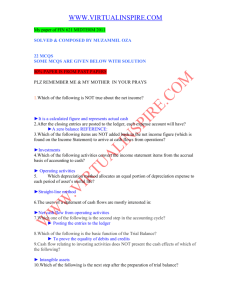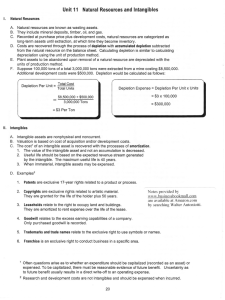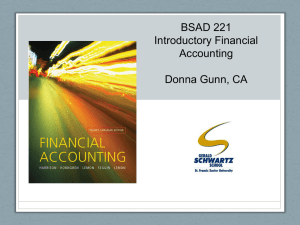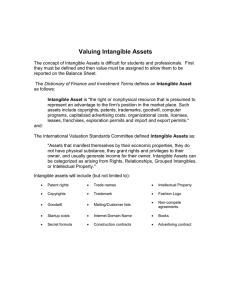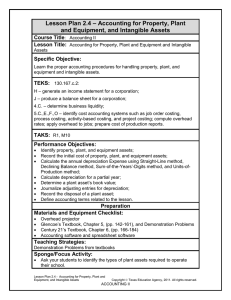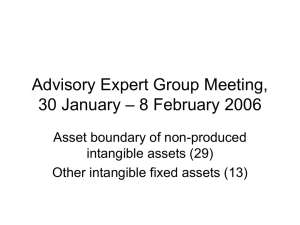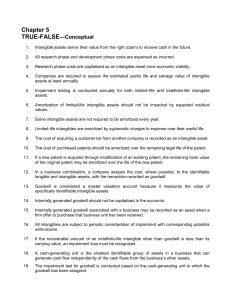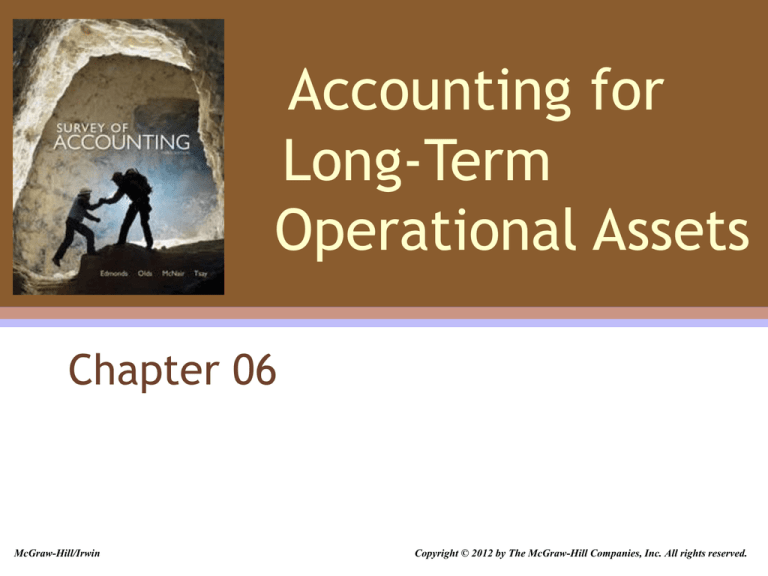
Accounting for
Long-Term
Operational Assets
Chapter 06
McGraw-Hill/Irwin
Copyright © 2012 by The McGraw-Hill Companies, Inc. All rights reserved.
6-2
Learning Objectives
1. Identify different types of long-term operational assets.
2. Determine the cost of long-term operational assets.
3. Explain how different depreciation methods affect financial
statements.
4. Determine how gains and losses on disposals of long-term operational
assets affect financial statements.
5. Show how revising estimates affects financial statements.
6. Explain how continuing expenditures for operational assets affect
financial statements.
7. Explain how expense recognition for natural resources (depletion)
affects financial statements.
8. Explain how expense recognition for intangible assets (amortization)
affects financial statements.
9. Explain how expense recognition choices and industry characteristics
affect financial performance measures.
6-3
Tangible versus Intangible
Assets
Tangible assets have a physical presence;
they can be seen and touched. Intangible
assets are rights or privileges. They cannot
be seen or touched.
6-4
Cost of Long-Term Assets
Buildings –
•Purchase price,
•Sales taxes,
•Title search and transfer document
costs,
•Realtor’s and attorney’s fees, and
•Remodeling costs.
Equipment –
•Purchase price (less
discounts),
•Sales taxes,
•Delivery costs,
•Installation costs, and
•Costs to adapt to intended
use.
6-5
Cost of Long-Term Assets
Land –
•Purchase price,
•Sales taxes,
•Title search and transfer document
costs,
•Realtor’s and attorney’s fees,
•Costs of removal of old buildings,
and
•Grading costs.
6-6
Basket Purchase Allocation
Beatty Company paid $240,000 for land and a building.
An independent appraiser provided these fair value
estimates: land $90,000, and building $270,000.
The $240,000 cost paid is separately assigned based on
% of total fair value.
Fair market value of building
Fair market value of land
Total fair market value
Amount
$ 270,000
90,000
$ 360,000
%
75%
25%
100%
6-7
Basket Purchase Allocation
The land and building that Beatty Company are assigned
their own allocation of the $240,000 paid based on the
individual % of total fair value. The “Allocation” is the
amount recorded in the accounting records.
Assign to building
Assign to land
$
Cost
240,000
240,000
%
75%
25%
100%
Allocation
$ 180,000
60,000
$ 240,000
6-8
Life Cycle of Operational Assets
Acquire
Funding
Buy
Asset
Retire
Asset
Use
Asset
6-9
Depreciation Method
1. Straight-line method - the same amount of
depreciation is taken each accounting period.
2. Double-declining-balance – produces more
depreciation expense in the early years of an
asset’s life, with a declining amount of
expense in later years.
3. Units-of-Production – produces varying
amounts of depreciation in different
accounting periods depending upon the
number of units produced.
6-10
Comparison of Methods
6-11
Intangible Assets
Trademarks
A name or symbol that
identifies a company or a
product. The cost of a
trademark may include
design, purchase, or
defense of the trademark.
Patents
The exclusive legal right to
produce and sell a product
that has one or more
unique features. The legal
life of a patent is 20 years.
6-12
Intangible Assets
Copyrights
Protection of writings,
musical composition, work
of art, or other intellectual
property. The protection
extends for the life of the
creator plus 70 years.
Franchise
The exclusive right to sell
products or perform
services in certain
geographic areas.
6-13
Intangible Assets
Goodwill
The excess of cost over fair
value of net tangible assets
acquired in a business
acquisition.
Net Assets are equal to
Assets minus Liabilities
Seller Company has Net
Assets = $230,000
Seller Company
Balance Sheet
At December 31, 20XX
Assets
$
280,000
Liabilities
Stockholders' Equity
Total
$
$
50,000
230,000
280,000
6-14
Balance Sheet Presentation
6-15
End of Chapter Six





